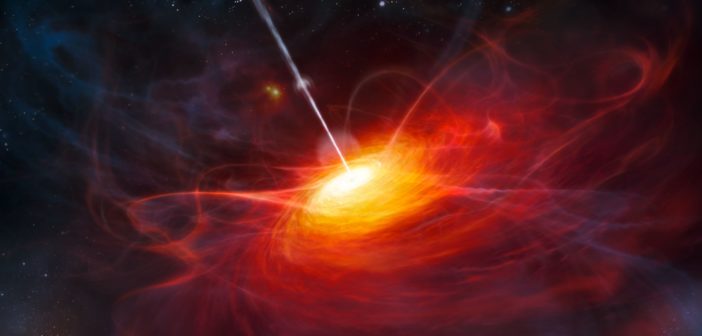Dramatic collisions of galaxies can provide fireworks shows in more ways than one. New observations have now confirmed a long-theorized link between galaxy mergers and the launch of powerful relativistic jets.
Feeding the Fire
We know that nearly every galaxy hosts a supermassive black hole of millions to tens of billions of solar masses. Some, like the one at the center of our own Milky Way, are quiet. But many actively accrete gas, flaring with bright emission across the electromagnetic spectrum. In addition to accreting material, some of these active galactic nuclei (AGN) also fling incoming material back out, forming powerful jets that zip along at velocities close to the speed of light.

When two galaxies collide, gas can be driven to their centers, feeding the supermassive black holes that lurk there. [NASA, ESA, and the Hubble Heritage Team (STScI/AURA)-ESA/Hubble Collaboration]
One Moment in a Long History
How can we test this theory? Galaxy mergers take billions of years, so watching one in real time isn’t an option. But if we spot galaxies that are mid-merger and that also sport AGN activity with young jets, that would provide reasonably convincing evidence that the jet production is related to the merger.
With this goal in mind, a team of scientists led by Vaidehi Paliya (Deutsches Elektronen-Synchrotron DESY, Germany) went on the hunt for evidence of young AGNs that might also be in the process of colliding — and they found what they were looking for in TXS 2116–077.
A Merger Caught Red-Handed
TXS 2116–077 lies 4.3 billion light-years away. Notably, this young AGN hosts a speeding jet at its heart, pointed close to our line of sight. Because the jet power is relatively low for an AGN, we can observe the accretion environment around TXS 2116–077 without being blinded by the jet’s emission.
Paliya and collaborators used the 8.2-m Subaru Telescope in Hawaii to image TXS 2116–077, revealing that this galaxy is in the process of merging with a nearby companion. Their close separation of just 40,000 light-years indicates that the two galaxies are in a late stage of merger and approaching coalescence.

This infrared image of TXS 2116−077, obtained with the Subaru telescope, reveals the presence of two galaxies interacting with one another. Overplotted contours show radio contours, revealing the compact jet. Click to enlarge. [Paliya et al. 2020]
Old Collision, Young Jet
By modeling the observed stellar populations, Paliya and collaborators estimate that the merger of these galaxies began ~0.5–2.5 billion years ago. The jet, in contrast, is estimated to be only 15,000 years old, based on its approximate length and speed.
The fact that the jet clearly formed after these two galaxies began merging provides strong evidence in favor of mergers as a trigger for AGN accretion and the launch of relativistic jets. Targets like TXS 2116–077 therefore represent ideal sources for studying newly formed jets and their birth environments.
Citation
“TXS 2116−077: A Gamma-ray Emitting Relativistic Jet Hosted in a Galaxy Merger,” Vaidehi S. Paliya et al 2020 ApJ 892 133. doi:10.3847/1538-4357/ab754f

1 Comment
Pingback: Physics and Astronomy | Update from PandA.